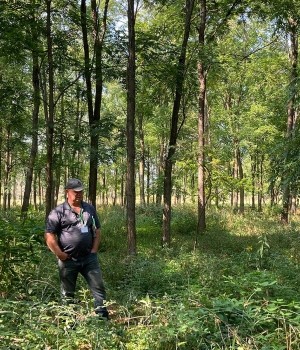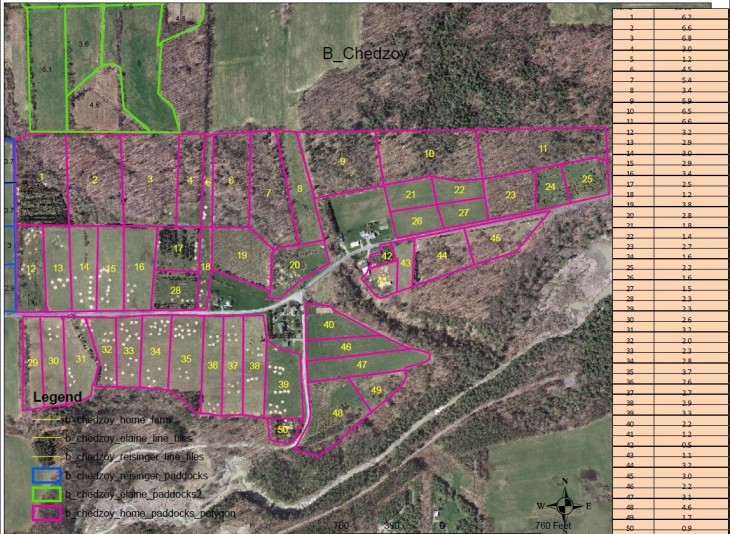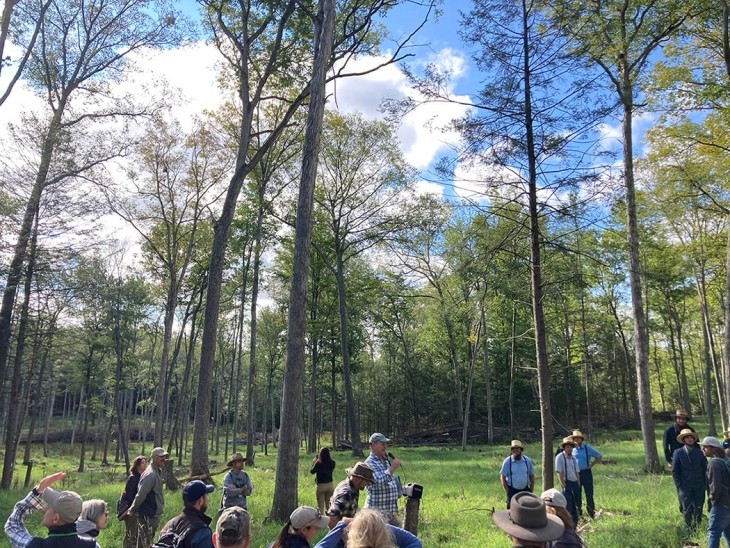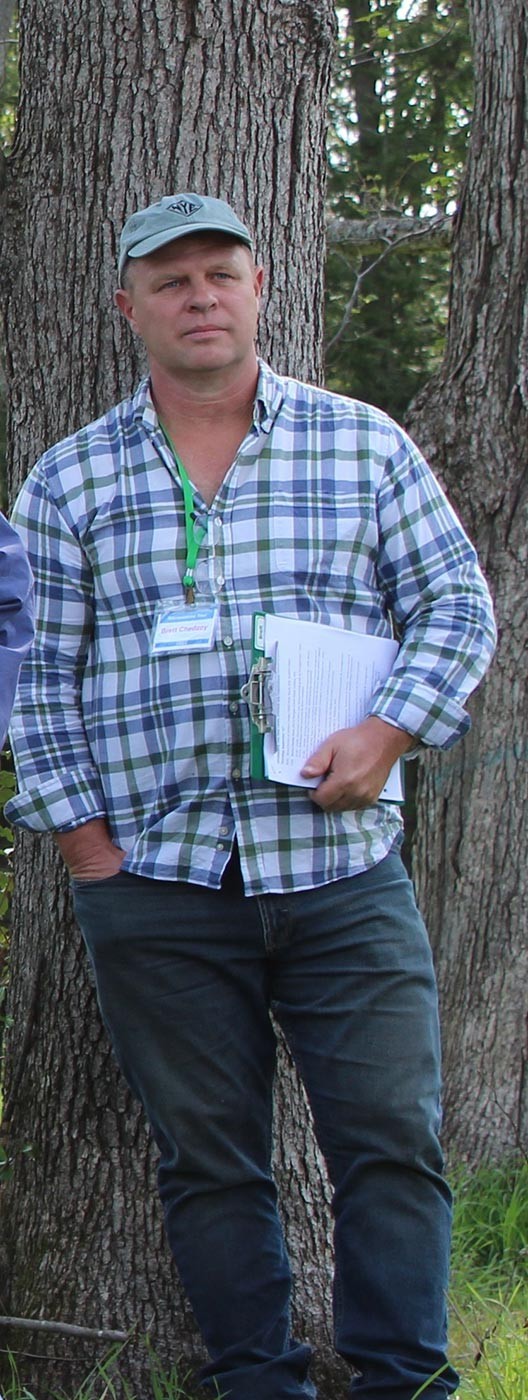
Brett Chedzoy has worked as a forester for the past 30 years. His work – and his interests – bridge forestry and agriculture. A forester with the Cornell Cooperative Extension since 2007, Brett is the senior resource educator in agriculture and natural resources, regional director for the Extension Master Forest Owner volunteer program, and manager of Cornell’s Arnott Teaching and Research Forest. Outside of his Extension duties, Brett and his wife Maria also own and manage a 500-acre farm in Watkins Glen, New York, and a ranch in Argentina – and raise both Aberdeen Angus and trees at each location, using silvopasturing techniques.
My interest in forestry started in childhood. I just always enjoyed being outdoors. In high school, when they start prodding you about what you may want to do for the rest of your life, it became clear I wanted some sort of career that was going to keep me outdoors most of the time. I went off to forestry school still not really having a clue what foresters did, but walking around in the forest sounded cool. I started college at Cornell, because the forestry school here in New York – SUNY-ESF – was still a transfer school at that time. After two years at Cornell, I continued on to the forestry school at SUNY-ESF. I graduated in 1991 from SUNY-ESF with my bachelor’s degree in forestry and did a masters a year later.
In 1992 I started two years of service in the Peace Corps in Argentina. I was working in a job very similar to what I do today as an extension forester. I was working for the local university. My role was to go out and help organize educational events around forestry, tree planting, and also support the forestry initiatives that were already happening in the area. Many of the people I worked with back then are still close friends to this day.
When Maria and I moved back to the US, we lived for a year in Washington, D.C., then moved to Connecticut. I worked for a forestry consulting company there. It was really a dream job for a young forester. We managed about 80,000 acres around southern New England, and every day I was out in the woods doing something different. The owners of that company were involved in an international consulting business that had a project in Argentina. In 1998 we moved back to Argentina so I could be the eyes and ears there. It was way up in the northwestern part of Argentina, about 1,000 miles from where Maria’s family lives – pretty rural, pretty remote. It was an amazing experience. Then we had three kids under 3, and at the same time the economy was going through its every-10-year meltdown. We moved back to where I grew up, in the Finger Lakes region, and we’ve been here now for 22 years.
Our farm is just west of the village of Watkins Glen, which is well known for wineries and racing and Seneca Lake and all sorts of other famous attractions. It’s the first farmland you come to once you climb up out of a deep glacial valley where the lake and the vineyards are. My dad grew up the next road over. As kids, we always hunted on this farm.
My parents bought this farm in the mid ’80s from close family friends. The couple that ran it as a dairy farm for decades was looking to retire and needed to sell the land. But back in the mid-80s, everybody was exiting from farming, especially dairy. Farmer Louie was bemoaning that they were probably going to have to chop the farm up into pieces and sell it to people who wanted to build homes here. My dad said something like, “Gee, that would be a shame to see such a beautiful farm get broken up.” And Louie said, “You and Rose come up for dinner tonight, and we’re going to work out a deal.” And my parents ended up buying the farm.
For my dad at that time, this was going to be his place to hunt and enjoy and raise the horses. Thirty-five years later, it’s grown into a 500-acre grazing farm. The farm is about half tree-covered and half in pastures, even though we’re still trying to turn a lot of open pasture land into these wooded grazing areas we call silvopastures. Today we raise 100 cow-calf pairs of Aberdeen Angus cattle, which seem to be a really good fit for our farm. Maria is from a farming family in central Argentina, and when we were married in 1994, we bought our own place there. So we’ve got a farm we’re trying to keep viable there and a farm we’re trying to keep viable here. The cattle and trees are a big part of the picture of both farms.
It took us a few years after we got back to decide what we really wanted to do with this big farm. In Argentina, at least at that point, there was no such thing as feedlots or raising ruminant animals on anything other than pasture. When we came back here, it seemed odd that cattle weren’t being raised in rotational grazing systems and finished on pasture and marketed as grass fed or grass finished animals. That’s what we were interested in doing.

We started raising animals really for our own purposes, but a small group of animals became an increasingly big group of animals. We found that the grazing was a very good fit for our farm. The fields became pastures, but the woods became pastures, too. Even though a lot of our tree planting happened 30-some years ago, we still continued to try to put more and more trees into what used to be crop fields, and now they’re pastures. It’s just a natural fit. The grazing animals – any day it’s over 70 degrees, they want to be in the shade. If we can grow nice trees and grow good quality pasture for the animals, too, it’s a win-win.
Here in the Northeast, we basically farm in the forest. Most of our family farms are at least partly wooded. Silvopasturing is an opportunity to use the whole farm for something that’s not only productive and, if done well, feasible and profitable, but can also be beneficial for other objectives. What led us to silvopasturing on our farm was partly these experiences in the 1990s that showed me that you could raise livestock and trees together on the same land, and not in a detrimental way.
This is very different from the long history of woodland grazing we have in the Northeast, where we just treat farm woodlots as “sacrifice packs” – basically you just throw the animals into the woodlot to get them out of the way and feed hay as needed. That’s obviously going to cause some negative impacts – soil compaction, or damage to trees, or the animals are browsing and eating things you don’t necessarily want them browsing and eating. In forestry school, the first thing they teach you is, “Thou shalt not raise the cows in the farm woodlot.” That was a model that came from our early European forest influences. Because in Europe, they had cleared all their forestland centuries ago, and the remaining fragments were for forest purposes, not for multiuse agroforestry purposes. Here, we’re in the opposite situation, where we have abundant forestland throughout most of the Northeast and relatively little agricultural land to meet our own food supply needs.
I was already familiar and comfortable with the concept of silvopasturing, which is the right way of doing it – with intensive rotational grazing and other management of the livestock to eliminate or minimize the negative associated impacts from many decades of essentially grazing our farm woodlots to death. In 2009, one of the collaborators on the Goats in the Woods project, Tatiana Stanton, who was our small ruminants specialist, agreed to give a presentation with me on silvopasturing over in the Hudson Valley area. We thought it would be a one and done deal. We had people show up from all over the Northeast. It was standing room only. Some of my other extension colleagues around the state caught wind of that and then they wanted to have silvopasture talks. One talk became several, and almost 15 years later, I think I’m up to close to 150 silvopasturing events. Those have ranged from low key pasture walks at local farms to conferences, tours, and trainings.
There’s a strong interest in silvopasture today both on the forestry side and on the agricultural side. I work with extension forester Peter Smallidge on these events. We think that it’s something that fits in very well into all the things that we have historically done and continue to do with forest rehabilitation and sustainable forestry practices and the viability of tree farms and farms. Many of the rural landowners that we interact with are always looking for ways that they can make their properties better by managing their properties, not necessarily taking a hands off approach.
Many of our woodlands, and particularly our farm woodlands, are not really in a healthy condition today, because of a long history of both exploitative management – the high-grading phenomenon – as well as things like emerald ash borer and other forests pests, our aging forest resources (trees don’t live forever), and the compounding effects of deer and problematic plants, both native or non-native. Today when old trees die – whether we cut them down or from a pest or storm – it’s not baby trees of the same species that are waiting there ready to take their place.
When my parents bought the farm in 1987, it was a beautiful woods, but I knew it had a lot of plants that were going to prevent the continuation of that beautiful woods. I did what I think most of us feel compelled to do – I went out there and spent a lot of time trying to cut down and poison and bulldoze bad plants. Every time I’d come back to the farm, I’d go out and look at where I’d spent a lot of time and money and realize the bad plants were replaced with more bad plants. If you create a void, nature is going to fill that void.
I saw silvopasturing – the incorporation of livestock in an intentionally managed way – as the easiest and best fix to a number of forest health issues at our farm. In essence, it started with using our livestock as the workforce to go out there and try to reduce the abundant and problematic understories of mostly non-native woody shrubs in our forest. We realized that we need to do something initially to get the bad plants under control, whether it’s heavy beech brush understories or heavy honeysuckle and European buckthorn understories. If we don’t have that grazing follow up, it’s going to quickly return to the conditions that we started with.
There are two directions from which we can create silvopasturing situations today – putting pasture into the woods or woods into the pasture. There are many different objectives in silvopasturing. I think grazer type farmers are doing it because they have this land that they want to use productively, but they also want to use the land responsibly and improve the condition and the productivity of the land over time. If we can shift it to a more stable perennial forage base, then that helps keep it in that more manageable state, so that when we reach the point where we want to naturally regenerate our farm woodlands, we’re starting with a much easier condition.
If I’m starting with a very dense understory or noxious herbaceous plants –these are very effective in disrupting the natural force succession and ecology. Grass is relatively easy to create the conditions for good natural regeneration, whereas dense, long-lived, shade tolerant, browse resistant understory of invasive shrubs – that is something that would be very challenging and costly to deal with to successfully be able to reestablish a new young forest. The forages are also a better quality food source for most wildlife.
Our forages here in the Northeast are what we call cool season forages. They don’t like hot, full-sun conditions. The very limited research that’s been done in a Northeast context shows that these forages are more productive in light shade than they are in full sunlight conditions. The silvopastures create those ideal conditions for these cool season forages to thrive.
With the pasture into the woods direction of silvopasturing, we’re working with what we have. Some of those trees may be the ideal trees – like oak or hickories or walnuts. But in other cases, they’re trees that may not be what we would normally think of as the most valuable tree or the best quality trees. They can be a little bit on the ugly side. But if they’re healthy and giving us shade and giving us habitat for both the grazing livestock and the wildlife and capturing carbon and protecting the watershed – then, they’re purposeful and useful trees.
There is a growing number of agroforestry consultants that are specializing more in putting trees into pasture environments. Their work is focused on areas that tend to be very high production agricultural regions where they don’t have a lot of trees. One of these companies is called Trees for Grazers, in Lancaster, Pennsylvania. What they’re doing is really creative and innovative, and they’re able to also find cost share incentives to help offset the investments. It’s expensive to plant trees. These are high production grazing dairies. Dairy cattle in particular suffer tremendously from heat stress. So these farmers can build more barns at hundreds of thousands of dollars a pop to provide more shade for their animals, or for tens of thousands of dollars, they can plant trees and not create that concentrated nutrient issue that barns create – but also have an appreciating resource that’s adding value to the land and providing other ecological benefits.
Most of our forestry work today is in some way tied to how we can keep our forests healthy and how we can grow our forests to essentially sequester and store carbon. In 2018, New York passed a monumental climate bill called the Climate Leadership and Community Protection Act. As part of that carbon neutrality legislation, they have to figure out where to find the offsets, because you can only reduce the sources and emissions to a certain extent. So you have to have ways of sucking up and storing more carbon. Trees and forests are the best thing out there for doing that. Silvopasturing is widely recognized for being both carbon friendly and resilient, because silvopastures imitate farming in nature’s image.




